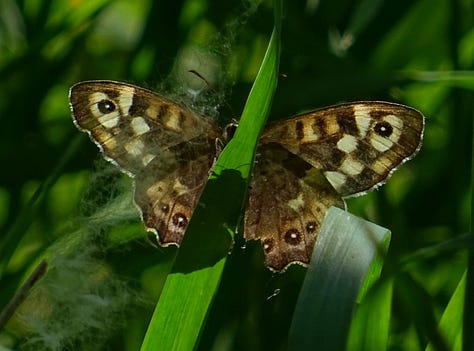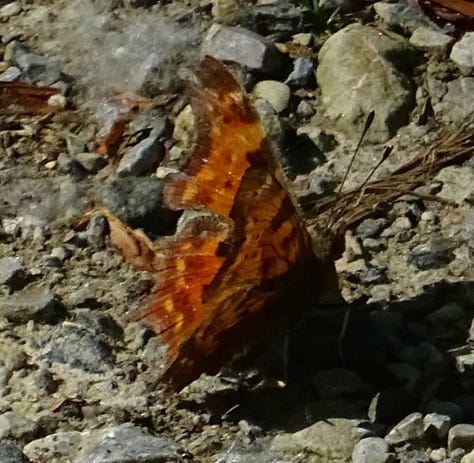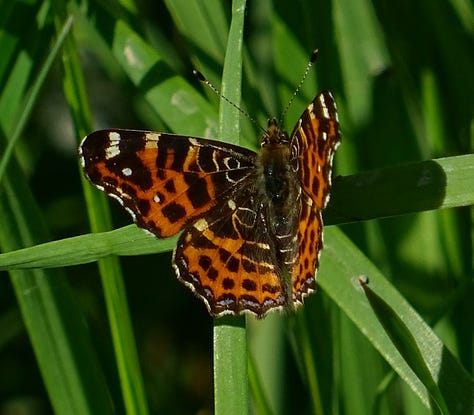Each month of 2025 will have a theme that guides my outdoor explorations and my reading.
Hi readers, Happy May! It’s the height of spring here. Spring, for me, means green everywhere, birdsong, wild garlic, kayaking, the first mountain trips, and reading on my balcony. And it definitely means that the insects are back! So, it’s high time for a month focused on Insects.
There are some insects I have been eagerly waiting for. I started to learn butterfly species identification last year, and I’ve been so excited to finally see butterflies out in nature again. Last week, on a warm, sunny, lazy day, I discovered a seemingly forgotten nature area with a chaos of bushes, trees, and boggy patches. It was full of butterflies: Speckled woods in the high grass, common brimstones fluttering between the bushes, a European comma on the trail ahead of me. I spent two hours there just observing and trying to remember what I learned last year.



Since I started getting to know winter trees, I have been visiting the same trees again and again, watching them change. One of my favourite trees is a horse chestnut on a meadow nearby. In winter, it carried large, sticky buds. In spring, leaves emerged, followed by little Christmas tree shapes (at least that’s what I think they look like) that have now developed into large clusters of flowers – white, pink, and yellow. The tree’s branches are thick with leaves at the outer edges of the crown, but closer to the trunk, it feels spacious – when I stand there, it is as if I am inside the tree. It is a strange, organic tower, like a place from The Lord of the Rings. But there are no elves here – instead, there are bumblebees! I like observing them crawl across the flowers and switch busily from one to the next, always making the sound of summer. This will be a delightful place to refresh my bumblebee knowledge this month. Bumblebees are considered a great start for insect species identification, not just because of their charisma: Their species-specific banding patterns in orange, yellow, brown, and white are (relatively) easy to recognise and memorise.


There are insects I hadn’t thought much about over the winter, and they’ve made for some of the small surprises of spring. I’ve seen several hornets over the last few days (or maybe it was always the same one returning?), exploring the area around my house. According to what I read, these must be the queens, as the males and workers don’t overwinter. The queens are looking for a good place for their nest now. There are also ladybirds and a variety of other beetles (for a great post about ladybirds, see here!), and yes, the mosquitoes are starting to appear… What I haven’t seen yet are my favourite insects, damselflies and dragonflies – they overwinter as nymphs or eggs in waterbodies, and the beautiful adults appear relatively late in the year, as they like warm weather. I’ll certainly be looking out for them later this month.
What else will I do this month?
Improve my insect identification skills. As there is a huge diversity of insects (e.g. more than 20,000 species in Great Britain and more than 30,000 in Germany), I find it important to set manageable goals! I will focus on common butterflies and bumblebees, plus the 30 or so most common insect species across all groups in my area.
Learn about the current insect decline and its causes.
Plant more wildflowers on my balcony and find out what else we can do to support insects.
Read insect-themed books.
Have you noticed the insects returning after the winter? Do you have a favourite?
Have a lovely week!
Hannah





So interesting! And I so much like your themes of the month. I absolutely love humblebees and butterflies and after I read your journal I definitely want to learn more. So thank you for your inspiration! 🦟🦋🐞
I can highly recommend the book Extraordinary Insects by Anne Sverdrup-Thygeson. Read it last year and loved it, it was fascinating and super accessible!